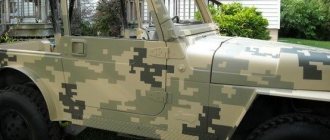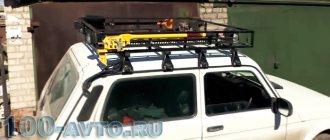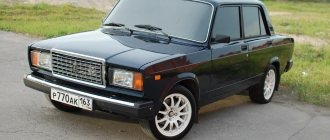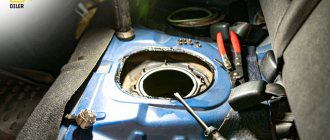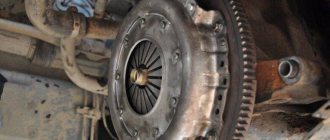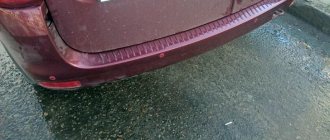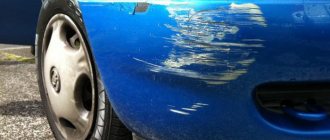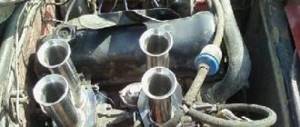During the operation of the car, the wing most often suffers, especially the front one. This happens during a small collision or unsuccessful parking. If the damage is severe, the wing needs to be replaced. It is worth remembering that such parts are not sold factory painted. In addition to the replacement itself, it is also required to paint it in a color as close as possible to the color of the car. And this is an additional blow to the budget if you contact a car service. If you have ever done minor car repairs, then if you have the necessary conditions and tools, you can do the painting yourself.
Painting the wing yourself will cost much less than in a car service
Selection of high-quality and inexpensive material
To paint the wing yourself, in addition to the paint itself, you will need the following:
- putty and primer;
- sandpaper / abrasive material;
- paper tape;
- car varnish;
- clean rags (without small lint);
- polyethylene, pieces of old newspaper;
- dense pieces of rubber (about the size of a palm);
- solvent.
The entire necessary list can be purchased at your nearest hardware store.
The last point deserves special attention. You will need 2 types of solvent. If the amount of work is small (painting one wing), you can purchase them in bulk, which will significantly help you save money.
&feature
Paint selection
The next important step is the choice of paint and varnish substance. You can paint the car fender with auto enamels. They contain pigments and additives that protect the car surface from water, fire, corrosion, etc. Main types:
- Melamine-alkyd one-component enamel. Pros: dense structure due to nitrocellulose in the composition, wear resistance, not afraid of gasoline; applied in three layers, does not spread; provides shine. Cons: takes a long time to dry, doesn't polish well.
- Acrylic two-component enamel. Advantages: high-quality protection against corrosion, atmospheric influences, air temperature changes, precipitation; easy to use, dries quickly; polishes well; durable. Disadvantages: relatively high cost.
- Nitroenamel is not a universal product and is only suitable for eliminating minor defects. Cons: does not give the surface a glossy shine, applies unevenly, requires a large number of layers (up to 10 sprays), takes a long time to dry, is flammable, fades quickly.
- Enamels with a metallic effect are distinguished between single-layer, two-layer and three-layer compositions. The latter give the surface a “chameleon” effect. The compositions dry fairly quickly (no more than an hour). The metallic coating looks much more impressive, besides, it prevents overheating due to light reflection, and also has greater durability. Cons: high price.
Melamine-alkyd one-component enamel
Acrylic two-component auto enamel
Automotive nitroenamel
Metallic Acrylic Enamel Please Note: Car Paint Drying Time
Necessary tool
The labor-intensive process of restoring the appearance of a car requires the use of improvised tools, auxiliary materials, etc. You will need:
- paper, newspapers, masking tape;
- abrasive agents (sandpaper, plane);
- degreaser (white spirit, kerosene, special solvents);
- spatula, putty, primer;
- spray gun, compressor, paint or aerosol can;
- rags, varnish, polishing paste and napkin;
- gloves, respirator, work clothes.
To complete the task, you need to prepare all the necessary means at hand in advance before starting repair work.
Sandpaper
Spray gun
Required Tools
The first step in painting a car fender is to have the necessary tools.
Necessary tools for work
You will need the following set:
- spray gun;
- compressor;
- putty knife;
- planers for cleaning.
What should you consider when painting a wing yourself?
The biggest problem you can encounter when painting a wing is dust. It may not be noticeable to the naked eye, and the garage may seem clean, but when exposed to a spray gun, it rises out of nowhere, subsequently creating a sandpaper effect on the painted fender. Therefore, when painting a car fender with your own hands, you should pay special attention to cleaning the room - thoroughly vacuum and wash the floor.
We paint the new wing strictly in overalls, which should include rubberized gloves and a mask. This way you can minimize exposure to harmful substances when inhaling paint and working with solvents.
Wing varnish coating
Immediately after applying the main base, you need to coat the wing with varnish. The preparation of this composition is carried out while the third layer dries. During this time, you need to carefully prepare the varnish, mix it with the hardener, as well as with the solvent in the proportion specified in the special instructions. After these preparatory works, the paint layer is wiped with a special antistatic cloth. Only after this can you begin the process of coating the wing with varnish.
The technology for applying varnish is no different from how paint is applied. It is usually laid in two layers to avoid serious shagreen. Immediately after applying one layer, you need to let it dry for about 20 minutes, it all depends on the ambient temperature.
When working with varnish, you should avoid smudges, since removing them will be quite problematic, especially if they are present on bends, as well as on stampings.
Stages of work execution
Painting work includes several stages, which must be performed strictly in the order in which they are indicated. Before you paint a car fender with your own hands, you need to properly prepare it. The surface must be perfectly clean and smooth, without any visible defects.
Before painting the wing, it is necessary to properly prepare it
It is worth not forgetting about workplace equipment. It is impossible to carry out work in poor conditions; the room must be clean and well ventilated. Dust is the main enemy of fresh paint.
Depending on the damage to the fender (scratches, dents or corrosion), the list of work may vary, but there is still one constant rule - the car must first be washed and dried. If the design of the car allows you to remove the wing, then it is easier to unscrew it and paint it separately.
A universal list of painting steps is given below.
Preparing and polishing the wing
Before restoring and painting the wing, it is necessary to carefully sand the damaged areas or the entire part as a whole.
How to grind correctly? You need to start from the places where the filler was previously applied. The abrasive wheel P80 – P180 is designed for them. Next, they move on to medium-grain sandpaper (up to P320) and treatment of the entire surface to smooth out the marks of primary sanding. At the completion stage, proceed to sanding with fine sandpaper. If necessary, stripping is carried out down to metal.
When sanding by hand, you need to apply proper pressure to the surface. Movements should be linear, not circular. Otherwise, large scratches will remain on the surface of the wing.
Sanding the wing before painting
Prime and putty the surface
After sanding, the wing must be puttied, after which the resulting smooth surface with a minimum number of open pores will be obtained. During the puttying process, the wing must also be sanded. To achieve an ideal result, more difficult areas must be sanded by hand.
You can do this as follows:
- Degrease the surface of the wing and apply universal putty.
- After drying, go over the surface with a block or machine with sandpaper from P100 to P320 (depending on the situation).
- Repeat the process until completely leveled.
After puttying, it is necessary to apply the primer with a spray gun in 2-3 layers at a working pressure within 3-4 atmospheres. Adjust the torch so that it resembles the shape of an elongated oval. Before priming, be sure to do a test on a test surface.
Apply layers with a break of 5-10 minutes (until one layer dries). The first layer should be thin, and the second should be denser.
Leave for 24 hours, then sand the top with P500 – P600 sandpaper if the part will be painted metallic.
Puttying the wing before painting
Painting
The painting process itself is much easier than the preparatory stages. Before you start painting, you need to decide how much paint you will need. On average, it takes 150-200 g to paint one wing, if we take test paints into account.
How to paint a car fender:
- Degrease the surface to be painted and wipe dry. If it is not possible to remove the wing, then insulate the surface of the car with newspapers and paper tape.
- Apply the sprayer in 2-3 layers, you must work with it wearing a mask and keep it at a distance of at least 30 cm. You need to wait 10-15 minutes between each layer. Apply until the paint covers all glimpses of the primer.
- Let the paint dry.
Typically, drying times vary depending on the paint used. It is usually indicated on the packaging. For example, acrylic paint dries in about 10 minutes.
Varnishing
The last step in painting the wing is varnishing. The varnish is applied after all layers of paint have dried. It will turn the coating into gloss and protect the paint from rapid abrasion and fading.
The varnishing process depends entirely on the type of varnish used. In addition, weather conditions are taken into account. If varnishing is carried out in winter, the holding time increases significantly.
The process of painting a car wing will not take much time.
If the wing defect is small, then it must be painted and varnished in sections. To avoid the difference between the old coating and the fresh varnish, use a transition solvent, which is filled with a spray bottle and lightly sprayed onto the transition boundaries. This is done if the side edges of the wing are damaged. If the damage is in the center, it is recommended to do a local touch-up and completely varnish the wing, rather than fill all the edges with solvent.
After the varnish has dried, a visual inspection of the wing is carried out. If there are minor defects, the varnish is polished by machine using abrasive pastes. To avoid deviations, it is recommended to strictly follow the painting plan.
How to paint a car fender with your own hands? Practical recommendations.
Stages of work
It is the car fender that most often undergoes minor repairs. It suffers most from minor collisions or poor parking. In this case, painting the car fender is required, which you can easily do yourself.
In fact, this is not such a difficult job and therefore you should not contact a car repair shop every time. After all, at home you can perfectly cope with this task, but you must meet a number of conditions and have all the necessary tools and materials.
Preparatory stage
It is the preparatory work that will take the most time. But without them, it will not be possible to achieve the desired result. First of all, you will need to prepare the place where painting will take place. This is usually done in the garage.
- To prevent any dust present from getting onto the freshly painted surface, you need to thoroughly vacuum the garage and wash it well.
- It is better to take out all unnecessary items or move them to a far corner and cover them.
- Before painting, the concrete floor must be thoroughly washed and watered.
In order not to waste extra time, you should collect all the necessary materials.
This includes:
- metal and rubber spatulas;
- sandpaper with index from P80 to P3000;
- automotive putty and primer;
- selected paint and varnish;
- technical solvent and degreaser;
- stripping planes;
- antistatic wipes, tape, films and old newspapers.
You will also need a set of necessary tools for disassembly and equipment such as a compressor and a spray gun. Only after this can you begin to carry out the work directly.
Preparing and polishing the wing
Before painting, you must thoroughly wash the entire car and dry it well. It would be best to remove the front fender. True, you will have to unscrew the fender liner, headlight and bumper to do this.
To make it easier to work on the rear fender, it will be necessary to remove the door seals, feet, hatch and other components.
Then the entire car, and especially the adjacent areas with the wing, must be well covered with film, masking tape or paper. This will prevent any primer or paint from coming into contact.
The wings need to be thoroughly degreased and inspection begins. It is necessary to identify all the scratches and defects that have appeared. To do this you will need a stripping plane.
The resulting rust is removed using P120-180 sandpaper or using a converter that quickly reduces iron oxide.
While working, keep white alcohol or another solvent on hand and degrease immediately. At the same time, we must try to carry out this stage as quickly as possible.
Primer and putty
The primer will prevent further spread of rust. It dries in about half an hour, and then it is also sanded with a fine abrasive material and immediately degreased.
Automotive putty is applied using a special spatula. With its help, it is necessary to eliminate all deep and remaining minor defects.
- The putty comes complete with a hardener. After thoroughly kneading, you need to make sure that there are no lumps. The time for working with putty is limited. There are only seven minutes before it starts to harden.
- Using a spatula, take a small amount of material and apply it across the dent. Only then can it be gradually spread along the length and leveled out.
- After applying the first layer, you need to clean the spatula with a solvent and wait until it dries completely. This will take approximately 30 minutes. Then you need to clean and degrease the layer and apply a new one. If the dent is large, you will have to fill it several times.
- When the putty has completely dried, you should begin cleaning and removing excess dried particles. You will need sandpaper P60-180, which needs to be changed more often. It is best to use a sander, although a simple wooden block with an abrasive material screwed onto it will also work.
- During this operation, under no circumstances should water enter, which could erode the putty. Many people wet fine sandpaper and then wipe everything dry.
- P500 is used to treat the edges of putty to smooth out the transition. For this you will also need matting paste or P1000-1200. True, sandpaper is still preferable.
Related article: Painting a car in chrome: from A to Z
Surface preparation
Preparation also includes several steps regarding stripping, sanding and priming. In many ways they are similar to previous operations.
- The surface is again cleaned of dust and well degreased.
- Sanding occurs in stages and using different sandpaper (from P180 to P240). The processing area is gradually increased to avoid uneven transition. It must become absolutely smooth to the touch, otherwise the difference will be visible after painting. Therefore, it is necessary to remove all dust and degrease the surface more often.
- For priming, epoxy or reactive primer is suitable, although a two-part primer can be used. Before doing this, it is important to read the instructions and follow all proportions. After all, you will need to mix the primer with a solvent and a hardener. Since it hardens quickly, it is better to take a small amount. For one wing, 150 grams of soil is usually enough.
- When applying the primer, you should try to maintain parallel lines. You may have to do two or three layers, leaving a 20-30 minute break between each coat. This will eliminate unnecessary drips.
- After complete drying, sanding with a fine-grained abrasive will be required again. Mostly they use P800. All generated dust is removed and the degreasing process occurs.
One point must be taken into account. If the front fender is to be painted, it is better to put it back in place before priming. It is better not to touch the body with your hands anymore, since the painting process itself remains.
Dent Removal
But before that, you need to once again pay attention to the resulting dent or damage.
If it is small, then simply filling it with putty will be enough. If the surface is not severely damaged after the impact, then it is not necessary to remove all the old paint and primer.
If the damage is large enough, then you need to remember that many layers of putty can cause severe shrinkage over time. This is especially true for alkyd and nitrocellulose putties. The total thickness should not be more than 0.3 mm. But epoxy allows you to apply up to 2 mm. The shrinkage here is minimal.
Paint color selection
Of course, the selection of the required shade is best done in workshops or specialized services. To do this, they have the necessary equipment and experienced personnel.
Therefore, it is not enough to name the factory paint markings. Over time, it may change color slightly. A small painted part will allow you to quickly select the right paint. Even the gas tank flap is good. The main thing is that it is not plastic.
If you can find suitable canned paint in the store, that will be nice. But you can make a computer selection. True, it is not so cheap and costs on average $15 per 100 grams.
Related article: What is gravitex and how to apply it to individual parts of your car? Answers and recommendations.
The most commonly used coating is automotive enamel. It contains not only a coloring pigment, but anti-corrosion, water-repellent and fire-resistant elements. Three types of such coating are mainly used.
- Nitroenamel lays down in a fairly thin layer and is suitable for minor damage. Otherwise, at least 10 layers will be needed to cover. In addition, it lays down somewhat unevenly and does not have the desired glossy tint.
- Alkyd enamel is usually applied in three layers. The dense structure is provided by nitrocellulose. The wing gains shine, and the enamel actually does not crack and is not afraid of gasoline. But we must take into account that it takes a long time to dry and is difficult to polish.
- Acrylic paint appeared relatively recently. It consists of a combination of different resins, polyurethane and various stimulants for hardening. Therefore, it not only applies quickly and easily, but also dries and polishes well. In addition, the wing acquires a glossy shine. It is worth adding about a long service life and good resistance to various external influences.
Only after this do they begin the final stage.
Painting the rear fender, like the front fender, will not require much effort or time.
Material application process
If the paint is in a can, you will need a compressor and a spray gun. Although very often it is found in cans, which greatly simplifies the entire procedure.
- Applying the first layer will immediately reveal many defects that were not eliminated during previous operations. It’s not for nothing that it’s called a darkroom. Therefore, it is not necessary to try to do it with special care. You just need to carefully draw horizontal parallel lines and start from the top.
- All defects and errors that appeared during the application of the developing layer are immediately eliminated using putty and primer. The technology for their application remains the same as before.
- The second layer is applied perpendicular to the first. This method is considered the most effective for evenly distributing paint.
- In order to prevent unnecessary drips in any case, the spray gun or spray can should be kept at a distance of about 30 centimeters from the wing. If you increase or decrease it, you may get a non-uniform surface.
- Each layer should dry at least a little. This requires 10 to 20 minutes. It's a good idea to wipe it down with an antistatic wipe every time.
- To ensure that the layers dry out more successfully, you should monitor the room temperature in the garage. It should be 20-25 degrees. A lower temperature will require more time.
Wing varnishing
Preparation for this stage begins already during the application of the third layer of paint on the wing.
The varnish must be mixed in advance along with the hardener and solvent. The required proportions are usually indicated on the packaging.
The process of applying varnish is similar to painting. There's just a slight difference. You don't need to use too many layers here, two will be enough.
After applying the first layer, you need to wait for it to dry for 20 minutes. Then you can apply a second layer. The main thing is to prevent leaks. Therefore, the same rules are followed as when painting.
It should be noted that the varnish can dry completely only within two days. Only after this the updated wing will be able to serve for quite a long time.
Recommendations from experts
Do-it-yourself painting of a new wing is done using a sprayer at a distance of at least 30 cm strictly perpendicular to the surface, otherwise the result may be a non-uniform shade.
If painting is done in warm weather, allow each coat of paint to dry for at least 20 minutes before applying another. As a rule, the manufacturer writes detailed instructions for the paint, which you must read before starting work.
Each layer of paint should lie extremely evenly, without smudges. Gaps are allowed only when applying the first layer.
According to the recommendations of experts, to obtain an ideal result after finishing the fender painting work, it is recommended to polish the entire car. This way, the car will look like new, and the freshly painted wing will not be conspicuous by its shine.
Preparatory stage
Preparing for DIY painting primarily depends on the degree of damage to the wing surface. Scroll:
- it is enough to polish the slightly damaged outer layer;
- more serious scratches and chips require preliminary putty;
- severe dents require the removal of all layers (paint, primer) and the application of a new coating.
The painting of the front fender, as well as the painting of the rear fender, is carried out using identical technology. Algorithm of preliminary manipulations:
- Cleaning. Before starting work, the machine must be washed and dried. The element that requires updating should be removed, cleaned, and degreased. Cover parts of the body that are not to be painted with paper and masking tape.
- Grinding. Inspect the surface for damage and corrosion plaques:
- lightly sand small scratches and chips with sandpaper until a matte finish appears;
- Serious damage, corroded areas are cleaned with P120-P180 sandpaper. It is allowed to use a chemical composition (rust converter) that reduces iron oxide;
- We sand the new wing and remove the factory primer.
- Degreasing the surface. During and after sanding, treat the coating with a degreaser (white spirit, acetone, etc.). Auto mechanics advise doing all procedures quickly to avoid the harmful effects of corrosion on unprotected metal.
- Putty. The presence of irregularities and deformations on the car wing indicates the need to apply the putty composition using a spatula in small portions. The process of mixing the putty with the hardener will take less than a minute, and application to the area will take about seven minutes. Otherwise, the composition will harden and lumps will appear. In some cases, a second coat is required. After each of them, we clean the surface, degrease it, and clean the tool with a solvent. To speed up the process, dry the coating with a hairdryer. Afterwards we process it with fine-grained (P1000) sandpaper.
- Padding. We successively apply three thin layers of primer to the prepared area, allowing each of them to dry for half an hour. We apply the soil using a spray gun or a spray can in even parallel lines at a distance of twenty centimeters from the body with a slight overlap of the previous coating. Hardening occurs quickly; one wing will require approximately 150 g of soil.
- Final sanding. Finally, a fine-grained abrasive is required. We roughen the surface for better adhesion with the coloring composition, remove dust particles with a special sticky cloth, and degrease. You can start painting the wing.
Old paintwork needs to be removed
Puttying and priming the wing Please note: Painting car wheels: selection of composition and processing nuances
Cost of painting a wing at a car service center
The most popular choice is two types of paint - acrylic enamel and metallic. In the first case, purchasing consumables costs around 2000 rubles, and in the second – 2400-3000 rubles.
If you resort to the services of a car service, then painting a car wing costs 2000-2500 rubles. more expensive if you add this cost to the main consumables. This is the case if the damage is not serious. In other cases, painting the wing will cost a tidy sum (about 10,000 rubles). If you've ever had to deal with car repairs and have your hands in the right place, then painting your car fender yourself will significantly save your budget.
